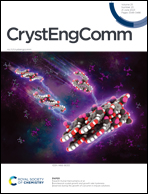The relationship between the crystal habit and the energy framework pattern: a case study involving halogen bonding on the edge of a covalent bond†
Abstract
The relationship between solid-state supramolecular interactions and crystal habits is highlighted based on experimental and computational analysis of the crystal structure of strong halogen-bonded (HaB) associations between iodine-containing dihalogens (ICl, IBr) with 1,4-diazabicyclo[2,2,2]octane (DABCO) as well as with substituted pyridines and phenazine. The pattern of the energy frameworks and the interplay of the attractive and repulsive interactions in the solid-state associations involving these HaB donors and acceptors directly correlated with their crystal habits. This correlation suggests that analysis of the energy framework serves as a useful tool (complementary to the earlier developed methods) to rationalize and predict the crystal habit. The X-ray structural analysis also revealed that the I⋯N distances in the complexes were in the 2.24–2.54 Å range, i.e. they were much closer to the I⋯N covalent bond length than to the van der Waals separation. The computational analysis of the nature of halogen bonding in these complexes showed delocalization of their molecular orbitals' between donor and acceptors resulting in a substantial charge transfer from the nucleophiles to dihalogens and elongation of the I⋯X bond. As a result, both I⋯N and I⋯X bonds in the strongest complexes (e.g., ICl with DABCO or 4-dimethylaminopyridine) are characterized by the comparable Mayer bonds orders of about 0.6, along with the electron and energy densities at their bond critical points of about 0.1 a.u. and −0.02 a.u., respectively. These data as well as the density overlap regions indicator (DORI) point to the covalency of the I⋯N bonding and suggest that the interaction within the IX complexes can be described as (unsymmetrical) hypervalent 3c/4e N⋯I⋯X bonding akin to that in trihalide or halonium ions.



 Please wait while we load your content...
Please wait while we load your content...